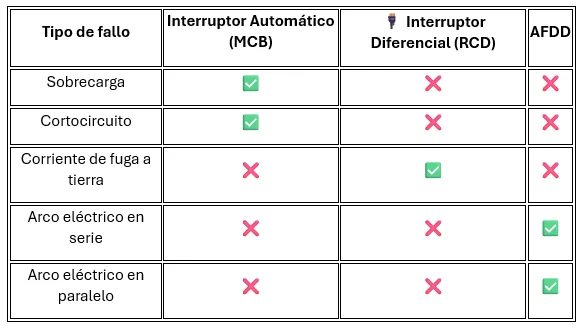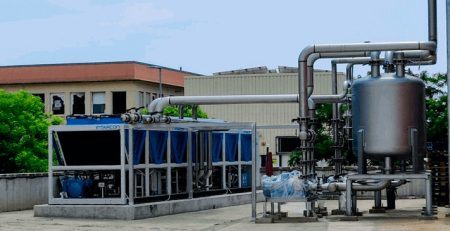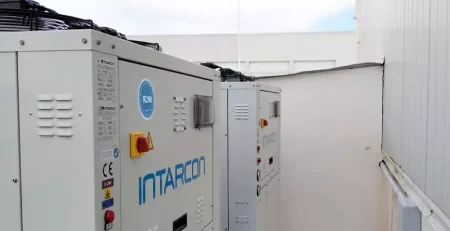Protecciones Eléctricas Modernas: La Importancia de los Detectores de Arco Eléctrico (AFDD)
Jorge Ramirez2024-11-27T12:45:30+01:00La evolución de las protecciones eléctricas: Más allá de los interruptores tradicionales
En el ámbito de las instalaciones eléctricas, la seguridad ha dado un gran salto gracias a la introducción de dispositivos como los Detectores de Arco Eléctrico (AFDD). Aunque los interruptores automáticos y diferenciales han sido pilares fundamentales de la protección eléctrica, los AFDD abordan un tipo de falla que los sistemas tradicionales no pueden gestionar: los arcos eléctricos peligrosos. Incendios causados en instalaciones antiguas con malos contactos, cableados deficientes o donde conviven dispositivos electrónicos en los que un pequeño diodo o un condensador puede fallar, son el escenario común que vemos semanalmente en los telediarios de un incendio catastrófico.
¿Qué son los AFDD y en qué se diferencian de otros dispositivos?
Un AFDD (Arc Fault Detection Device) es un dispositivo diseñado para detectar patrones específicos de arcos eléctricos peligrosos, ya sean en serie (dentro de un cable dañado) o en paralelo (entre conductores). Estos no generan corrientes suficientes para activar un interruptor automático o diferencial, pero sí pueden provocar incendios.
Comparativa con dispositivos tradicionales:
- Interruptores automáticos (MCB): Actúan ante sobrecargas y cortocircuitos. No detectan arcos eléctricos en serie o paralelo que no superen su límite de corriente.
- Interruptores diferenciales (RCD): Actúan ante corrientes de fuga a tierra, protegiendo contra contactos indirectos y electrocución. No son sensibles a fallos de arco que no impliquen fugas a tierra.
- AFDD: Detectan arcos eléctricos peligrosos mediante el análisis de la señal de corriente, desconectando el circuito antes de que el calor generado provoque un incendio. Especialmente eficaces en instalaciones con cables dañados o conexiones flojas.
¿Cuándo actúa cada dispositivo?

¿Por qué los AFDD son imprescindibles en instalaciones modernas?
- Mitigación de riesgos en entornos domóticos: En sistemas con alta densidad de dispositivos electrónicos, como iluminación inteligente o sensores, el desgaste de cables y conexiones puede derivar en arcos eléctricos. Los AFDD complementan las protecciones tradicionales, garantizando la seguridad de equipos sensibles y personas.
- Prevención de incendios en edificios vulnerables: Edificios de madera, hospitales, hoteles y lugares con alta afluencia de público son escenarios donde los AFDD actúan como una barrera crucial contra incendios eléctricos.
- Cumplimiento normativo y protección avanzada: En España, aunque no son obligatorios de forma general, la ITC-BT-24 del REBT recomienda su uso en locales con riesgo de incendio, como almacenes y edificios históricos.
Un caso práctico: ¿Cómo trabajan juntos?
Imagina un sistema eléctrico con un cable dañado detrás de una pared. Este cable comienza a generar arcos eléctricos en serie debido al desgaste del aislamiento:
- Elinterruptor automático no actúa porque no hay sobrecarga ni cortocircuito.
- Elinterruptor diferencial no detecta el fallo porque no hay fuga a tierra.
- ElAFDD identifica el patrón característico del arco eléctrico y desconecta el circuito antes de que el calor generado provoque un incendio.
Conclusión: Seguridad integral con protecciones complementarias
Los AFDD no sustituyen a los interruptores automáticos o diferenciales, sino que los complementan, cubriendo un área crítica de protección que los dispositivos tradicionales no abarcan. En un entorno donde la tecnología y la seguridad eléctrica evolucionan rápidamente, estos dispositivos son una inversión esencial para evitar riesgos que podrían tener consecuencias catastróficas.
¿Estás preparado para llevar la protección eléctrica de tus proyectos al siguiente nivel? Déjanos tus comentarios o ponte en contacto para explorar las soluciones más seguras y eficientes para tus instalaciones.
Elaborado por: Manuel García Jiménez




